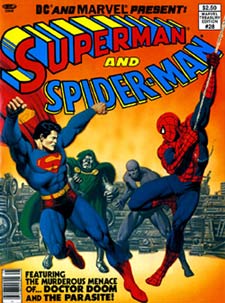 Superman
and Spider-Man
Superman
and Spider-Man
Five years after their first pairing,
Superman and Spider-Man
cross paths gain in Marvel Treasury Edition #27.
This time around, Jim Shooter provides
the script and John Buscema the pencil
art, with inking chores shared by a who's-who of Bronze
Age talent: Joe Sinnott (on figures), Terry
Austin, Klaus Janson, Bob McCleod, Al Milgrom, Steve Leialoha,
Walt Simonson, Bob Layton, Joe Rubinstein and Bob
Wiacek (all chipping in to finish backgrounds).
We open in Manhattan, where Spider-Man foils an attempt
to rob a bank adjacent to a construction site. His spider-sense
gives him an uneasy feeling about the location, but before
he can investigate the NYPD arrives and chases him off.
Meanwhile in an underground complex beneath the construction
site, Dr. Doom watches via closed-circuit
TV.
At this point, we're only on page four, but we've already
noticed one thing: people in this book like to talk. I mean,
they like to talk a lot. For instance, here's Dr Doom as
he finishes spying on Spidey:
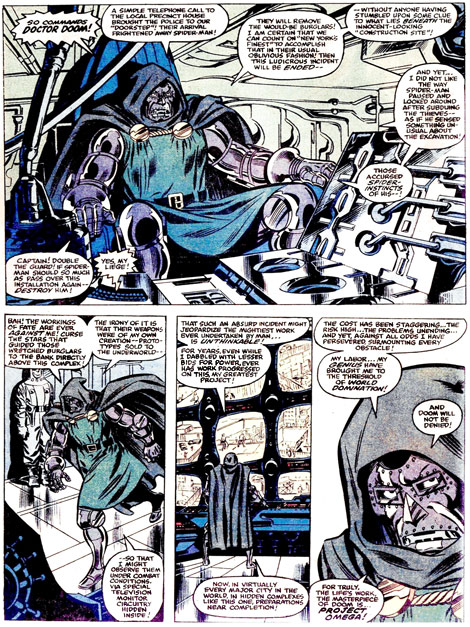
And that's when he's in a room by himself! Letterer Joe
Rosen really earns his pay on this one; if there
were any justice in the world, he'd get his name higher
up in the credits, or even on the cover. Of course as letterer,
he probably could've snuck his name in wherever he wanted,
but by the time it occurred to him his wrist was probably
already in a cast.
Shooter seems aware of his own verbosity, though, and (I
think) mocks it on the next page, where Doom directs an
underling to
J. Jonah Jameson rejects Peter
Parker's photos of the foiled bank heist ("Spider-Man
is old news in this town") and dispatches him to Metropolis,
where the Incredible Hulk is reportedly
headed. A confrontation between the Hulk and Superman, says
Jonah, would be real news.
In Metropolis, Clark Kent ducks out of
a Daily Planet staff meeting and as Superman goes after
the Hulk, who's been spotted tearing up the city. He tries
to calm the Hulk down, with predictable results:
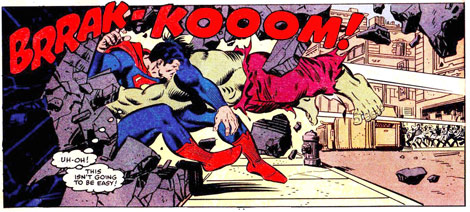
When Superman believes he's seriously injured the Hulk,
he goes to the monster's aid, only to receive a sucker-punch
that launches him clear across town. Peter Parker arrives
in Metropolis just as the fight breaks out, and changes
to Spider-Man to pitch in. However, Superman soon returns
to the fray and pushes Spider-Man aside to face the Hulk
alone. Planting his feet firmly, he stands fast against
the Hulk's full fury, hoping the behemoth will tire himself
out.
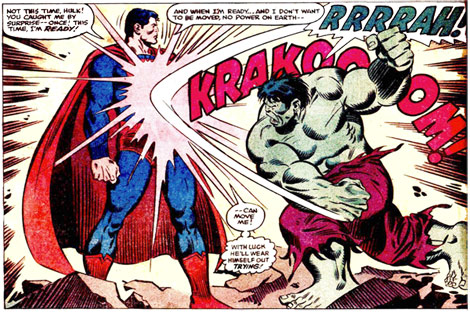
Superman spots a "micro-minature drone" flying
around the Hulk's ear and driving him mad with "an
ultrasonic screech." When Superman destroys the device
with his heat vision, the Hulk calms down and changes back
to Bruce Banner. Feeling useless, Spider-Man
slinks into an alley and changes back to Parker.
Not even the Hulk himself realizes that the real purpose
of his rampage (directed by an unseen figure) was to smash
a city street beneath which is an underground prison holding
the Parasite. Said villain escapes to the surface, exhausted
and near death until he detects great power nearby and drains
it...from Peter Parker. Nearly fainting, Pete is caught
by Jimmy Olsen, who buys him a cup of coffee and later introduces
him to Perry White, who puts him on the payroll as a Daily
Planet photographer.
Superman deduces that the only person capable of controlling
the Hulk in the fashion he witnessed is Victor Von Doom
(since Lex Luthor is "safely locked
away") and so he confronts him inside the Latverian
Embassy.
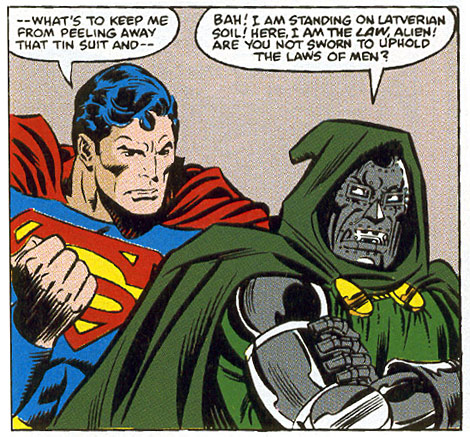
Realizing Doom and the Parasite may try to strike at him
through his friends, Superman decides to stay in New York
as Clark Kent to draw their fire. J. Jonah Jameson is only
too happy to give him a temporary job at the Daily Bugle
("This more than makes up for that turncoat Parker
selling out on me!").
As well as things are going for Pete at the Planet, however,
bad luck continues to plague him as Spider-Man. On his first
patrol of the city, a misunderstanding quickly sours his
relations with the Metropolis Police Department.
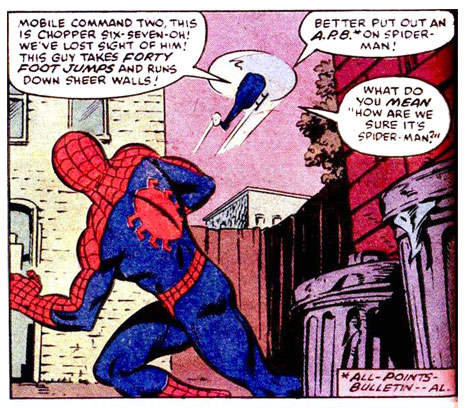
Spidey comes across a construction site very much like
the one he saw in New York, and gets that same tingly feeling
about it, so he pokes around until he finds a hidden hatch
in the ground, and an underground facility beneath. As it
happens, Wonder Woman has gotten there
ahead of him, and is already in battle with Dr Doom's army.
Again the wallcrawler's reputation precedes him, and WW
attacks him, until Spider-Man turns out the lights -- giving
him a tactical advantage he declines to exploit -- and convinces
her he's on the side of the angels.
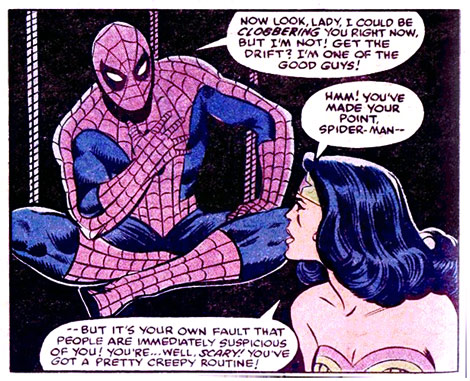
More of Doom's forces arrive and Wonder Woman is captured,
but Spidey escapes. Doom's men place the unconscious Wonder
Woman aboard a secret underground railway train connecting
Metropolis to New York, not knowing Spider-Man is a stowaway.
In his New York base, Doom reveals his plans to the Parasite
(and us). He has built underground bases all over the world,
each housing an "Omega Station" that will emit
"a peculiar radiation which will permeate the Earth's
crust and mantle." The effect will be to turn "every
molecule of fossil fuel on this planet" into sand,
bringing a halt to commerce and industry and putting billions
at the mercy of the elements. Then Doom will step in and
offer a replacement energy source; his own huge fusion reactor
with an output "equivalent to a small star...sufficient
to power the totality of civilization!" His price for
access to this power? Absolute dominion over Earth, naturally.
The Parasite's place in all this? With the aid of Doom's
machines, he will absorb the power of Wonder Woman, the
Hulk (who's also been captured, between panels) and Superman
and serve as Doom's omnipotent enforcer and bodyguard against
whomever challenges his new role as ruler of Earth.
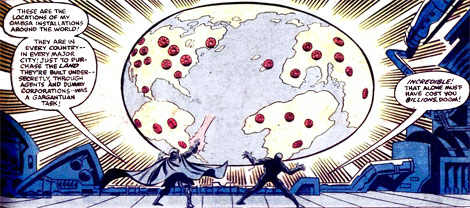
Spider-Man finds his way out of Doom's complex just as
Superman shows up, and together they confront the villains.
Doom uses a giant robot against Superman, while Parasite
duplicates Spidey's powers and takes him on. The villains
gain the upper hand and the heroes are captured.
Doom directs Parasite to don the device which will give
him his new powers, but the Parasite -- still possessing
spider sense -- intuits that the device will result in his
destruction (Doom plans to use his crystallized remains
to stabilize an imperfection in the fusion reactor). As
Spider-Man helps Superman escape, the Parasite and Doom
battle, in the process accidentally smashing the reactor
control panel and starting a chain reaction that will destroy
the Earth.
Superman contains the unstable core while Spider-Man (eventually)
figures out how to shut the reactor down. They chase Doom
to his embassy, where he claims asylum. Their work done,
the heroes return to their respective cities.
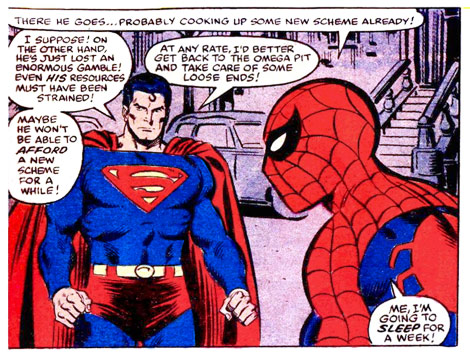
This book is printed as part of a Marvel line, in Marvel's
squarebound "Treasury" format and using Marvel's
creative talent, so unlike its predecessor it definitely
feels like "Superman visits the Marvel Universe."
This leads to some fun moments, as when New Yorkers spot
Superman flying overhead and butcher the time-honored Superman
intro: "Look! Up in the sky!" is answered by,
"Gimme a break, man! Who'd fall for that old line?"
and "Geez, is that Thor?"
Jim Shooter does a good job here of transplanting Superman
into such an alien environment. Poor Spidey is dumbfounded
at the way Superman has only to make an appearance and the
police offer full cooperation while the crowds look on in
admiration and awe...quite a contrast to the treatment the
wallcrawler endures. Also it's interesting (and endearing)
to see Spider-Man cope with the reality that he's no match
power-wise for just about anyone else in the book. There's
some effective humor in the way Jameson is repeatedly caught
short by Clark Kent's casual demeanor and "one step
ahead" maneuverings, cutting off Jonah's trademark
explosions before he even gets going.
Unlike his modern-day incarnation, this is not a Superman
who's used to confronting villains who elude prosecution
and exploit the weaknesses of the justice system. Maybe
that's why he looks so profoundly unhappy throughout the
book. In all the many, many panels in this long book the
facial expressions for Buscema's Superman run the gamut
from "dour" to "glum", with an occasional
stop at "surly." Actually, it gets kind of depressing.
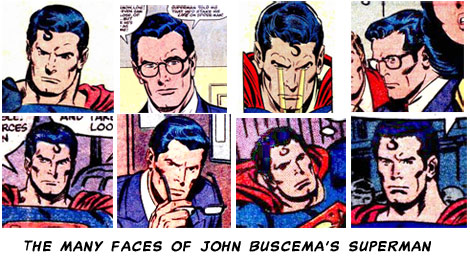
In fact, Superman frowns so much there's probably less
than two dozen panels in the whole book where he even opens
his mouth, and even then he's usually grimacing with clinched
teeth. Neat trick doing all that talking (and talking...and
talking) with his mouth shut. Super-ventriloquism, maybe?
That said, a huge appeal of this book in 1981, maybe even
its primary appeal, was seeing Superman drawn in the Marvel
style. Up to that point in history, DC had very tight controls
over how Superman was drawn, even replacing the heads on
figures drawn by the likes of Jack
Kirby and Alex Toth when they
didn't conform. In a mere five years, John Byrne
would arrive and usher in two decades of Marvel-style Superman,
but in 1981 it was still a wild concept.
In summation, this is a well-done story with no shortage
of action and some great moments fans in the early 80s had
waited a long time to see, like Superman meeting Dr Doom
and the Hulk. And though today I find the content incredibly
dense and wordy (there's only two splashes and nary a two-page
spread, unlike most original-content tabloids), at the time
I was just convinced I was getting more for my money. Plus
the inclusion of the Superman/Hulk tussle is a real "give
the people what they want" bonus.
On the whole, this is one sequel I like better than the
original, though of course your mileage may vary.

 Superman
and Spider-Man
Superman
and Spider-Man







